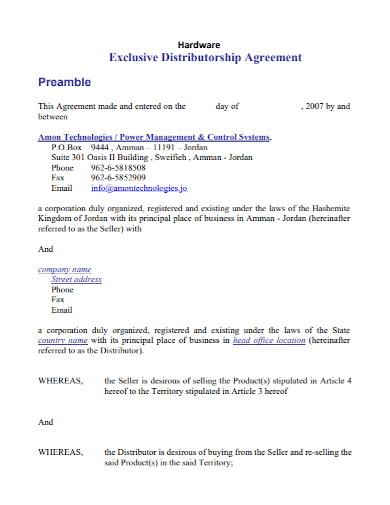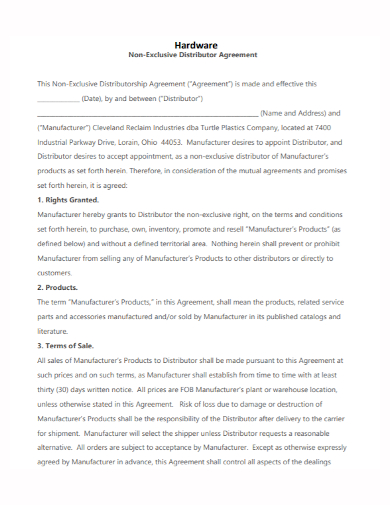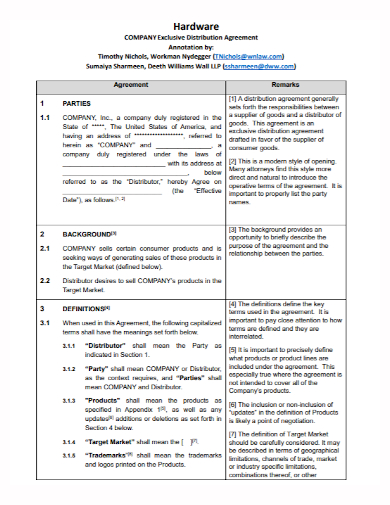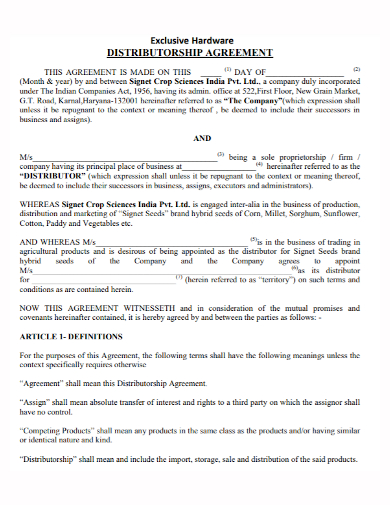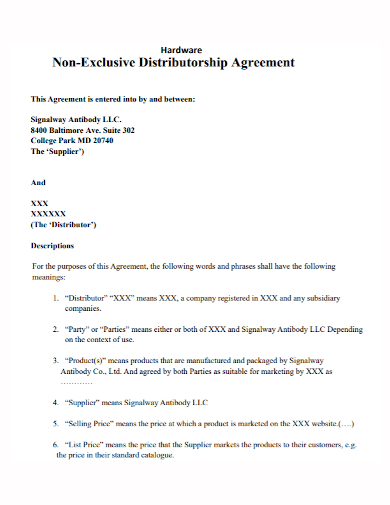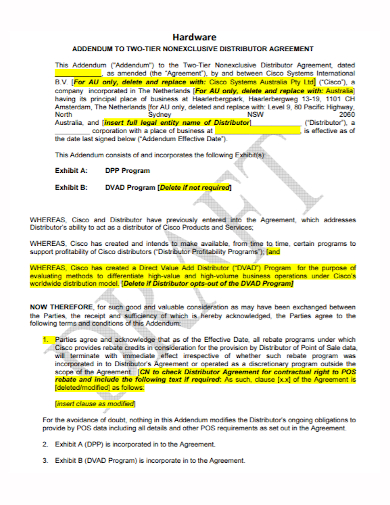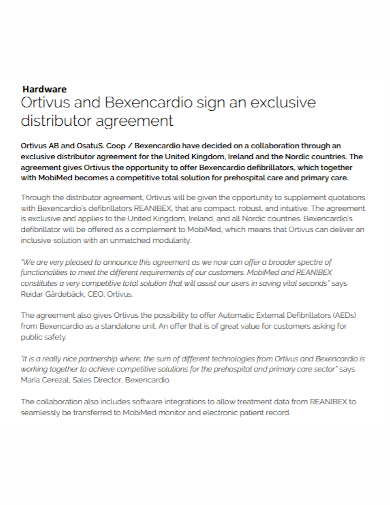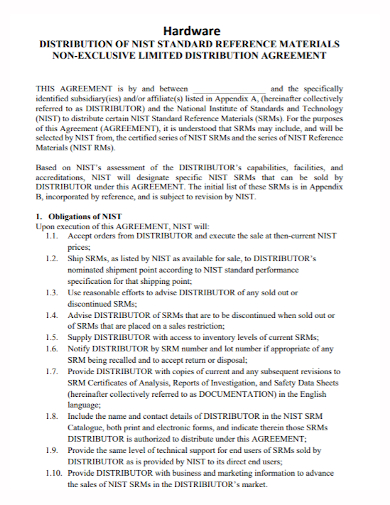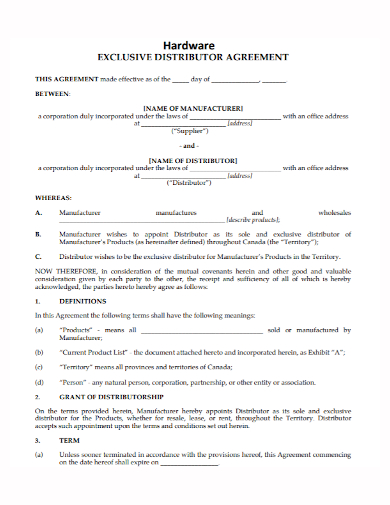In the distribution industry, a supplier is defined as an individual or organization that supplies or sells a product to a distributor on the distributor’s behalf. Suppliers are typically the companies that manufacture or produce the product in question. Suppliers are also referred to as manufacturers or producers. A distributor, on the other hand, is defined as an individual or organization who purchases a product with the intent of “distributing” it by reselling it to end consumers or through other distribution channels afterward. Under the terms of a Distribution Agreement, the products are transferred from the manufacturer to the distributor who then becomes the legal owner of the products.
It is a legal contract between two parties in which one of the parties (the “distributor”) agrees to sell and distribute the goods and services provided by the other party (the “reseller”) (the “supplier”). It is through the signing of a Distribution Agreement that the parties set forth their expectations for the sale and distribution of their products, in addition to the general behavior and boundaries of their relationship with one another. Check out these hardware exclusive distributor agreement samples that we’ve provided for you below to get a better understanding of what the document is and how it works. After familiarizing yourself with the document, you are welcome to use these samples as guides or even as templates for when you write your own version of the document.
10+ Hardware Exclusive Distributor Agreement Samples
1. Hardware Exclusive Distributor Agreement Template
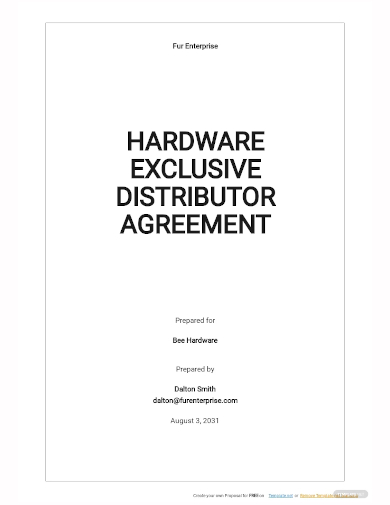
2. Hardware Exclusive Distributorship Agreement
3. Hardware Exclusive Distributor Agreement
4. Hardware Non-Exclusive Distributor Agreement
5. Company Hardware Exclusive Distributor Agreement
6. Sample Hardware Exclusive Distributor Agreement
7. Hardware Non-Exclusive Distributorship Agreement
8. Standard Hardware Exclusive Distributor Agreement
9. Basic Hardware Exclusive Distributor Agreement
10. Formal Hardware Exclusive Distributor Agreement
11. Hardware Exclusive Grant Distributor Agreement
What Is a Hardware Exclusive Distributor Agreement?
The term of the agreement (the length of time it will be in effect), the terms and conditions of supply, and the sales territories covered by the agreement (regions within and/or outside of the United States) are all essential components of a distribution agreement. The manufacturer or vendor must also decide whether the distribution agreement will be exclusive or nonexclusive in nature, depending on the circumstances. In an exclusive distribution agreement, the specified distributor will be the only distributor with the right to sell the product in a specific geographic region or in multiple geographic regions, depending on the terms of the agreement. Exclusive distribution agreements are used to protect the interests of the manufacturer and the distributor. It is possible that the manufacturer or vendor will supply other distributors, some of whom may be direct competitors in the same market as the original distributor if the agreement is not exclusive. Prior to deciding on the types of agreements to be entered into, the manufacturer or vendor must first determine their distribution strategy. To effectively cover the target markets of the channel partner, a limited number of distribution outlets is required. By utilizing a diverse range of distribution channels and methods, an intensive marketing strategy seeks to place the product in front of as many potential buyers as possible. Consumer-oriented products, rather than products intended for the commercial market, are generally accepted as having a higher likelihood of success. The scope of a distribution agreement may extend beyond national boundaries to include international distribution. Electronics and information technology distributors with a global presence, such as Arrow Electronics and Avnet as well as Ingram Micro and Tech Data, have branches and subsidiaries in numerous countries, which allows them to provide a broad geographic distribution network.
How To Use a Hardware Exclusive Distributor Agreement
- Depending on the circumstances, this document can be completed by either the supplier or the distribution company. If the user chooses to complete the document, he or she is responsible for entering all of the information required to complete it. It is recommended that the user print at least three (3) copies of the completed document after completing it.
- Any attachments to the document should be clearly labeled and attached to each and every copy of the document that has been printed or copied. If there are any attachments to the document, they should be clearly labeled and attached to each and every copy of the document that has been printed or copied. You are identifying the attachments when you mark them with the words “Annex “A,” “Annex “B,” and so on, on the attachments themselves to distinguish them from other attachments.
- Using the document as a guide, the user should make certain that all attachments are properly labeled. All of the attachments have been marked with a bold font to make them easier to locate. It is recommended that after the document has been printed and all attachments (if any) have been attached, the parties conduct a thorough review of the document and, if everything is found to be correct, sign all original copies in front of the other parties present.
- An Acknowledgement section is also included at the end of this document. An
acknowledgment is a declaration made in front of a notary public stating that a signature on a document was voluntarily affixed by him and that the document was completed as a result of his own free and voluntary act, which is known as a declaration of voluntariness. The act of acknowledging a document in the presence of a notary public converts the document into a public record in the eyes of the public. Self-authenticating public documents are commonplace, which means that no additional evidence will be required to demonstrate that the document was actually executed. If the document is to be acknowledged, it is necessary for the parties to appear before a notary public with all of the copies of the document in hand and swear an oath to the facts stated in the document. - One original copy of the document is retained by the notary public for his or her own records after it has been acknowledged by the notary public. It is recommended that a copy of the document be retained by both the supplier and the distributor for their own records.
FAQs
What are distribution rights?
A contract that grants a person or company the right to sell another company’s products or services in a specific geographical area or country; domestic and international distribution rights are examples of such contracts.
How do I become a sole distributor?
- Identify your industry. The first step to becoming a distributor is identifying the industry you’d like to serve.
- Register your business legally.
- Seek suppliers and manufacturers.
- Plan your logistics.
- Apply as a distributor.
- Build relationships.
Is distribution agreement a contract of sale?
In the sense that they involve the sale of goods, distribution agreements are similar to sales contracts in that they involve the sale of goods. It is a legal agreement between a manufacturer and a distributor that provides for the future sale of goods by the manufacturer to the distributor in exchange for payment.
Distribution agreements are only as good as the information contained within them, and the language contained within them is no exception. The unintended consequences of these legal blunders could have serious consequences if your agreement is found to be unenforceable or illegal in some way. If you want to make sure that your and your company’s rights are protected throughout the process of negotiating the agreement, you should consult with contract lawyers rather than leaving it to chance.
Related Posts
FREE 21+ Dealership Agreement Templates
FREE 15+ Marketing Contract Samples
FREE 12+ Distribution Plan Samples
FREE 10+ Sales and Marketing Agreement Samples
FREE 10+ Authorized Dealer Agreement Samples
FREE 10+ Distribution Channel Strategy Samples
FREE 9+ Authorized Retailer Agreement Samples
FREE 8+ Retail Distribution Agreement Samples
FREE 20+ Sample Sales Agreement
FREE 13+ Sample Marketing Consulting Agreement
FREE 11+ Sales Agency Agreement Templates
FREE 11+ Supply Agreement Contract Samples
FREE 10+ Standard Supplier Contract Samples
Simple Agreement
FREE 8+ Sample Business Listing Agreement

